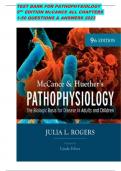lOMoARcPSD|287 025 75
TEST BANK FOR PATHOPHYSIOLOGY
9TH EDITION McCANCE ALL CHAPTERS
1-50 QUESTIONS & ANSWERS 2023
, lOMoARcPSD|287 025 75
Contents
CHAPTER 1: Cellular Biology ...................................................................................................... 4
CHAPTER 2: Altered Cellular and Tissue Biology ...................................................................... 17
CHAPTER 3: The Cellular Environment: Fluids and Electrolytes, Acids and Bases...................... 30
CHAPTER 4: Genes and Genetic Diseases ................................................................................ 43
CHAPTER 5: Genes, Environment-Lifestyle, and Common Diseases ......................................... 53
CHAPTER 6: Epigenetics and Disease ....................................................................................... 61
CHAPTER 7: Innate Immunity: Inflammation ........................................................................... 65
CHAPTER 8: Adaptive Immunity .............................................................................................. 79
CHAPTER 9: Alterations in Immunity and Inflammation........................................................... 90
CHAPTER 10: Infection .......................................................................................................... 101
CHAPTER 11: Stress and Disease ........................................................................................... 110
CHAPTER 12: Cancer Biology ................................................................................................. 118
CHAPTER 13: Cancer Epidemiology ....................................................................................... 131
CHAPTER 14: Cancer in Children ........................................................................................... 137
CHAPTER 15: Structure and Function of the Neurologic System ............................................ 142
CHAPTER 16: Pain, Temperature Regulation, Sleep, and Sensory Function ............................ 152
CHAPTER 17: Alterations in Cognitive Systems, Cerebral Hemodynamics, and MotorFunction
............................................................................................................................................. 165
CHAPTER 18: Disorders of the Central and Peripheral Nervous Systems and theNeuromuscular
Junction................................................................................................................................ 177
CHAPTER 19: Neurobiology of Schizophrenia, Mood Disorders, and AnxietyDisorders........... 188
CHAPTER 20: Alterations of Neurologic Function in Children ................................................. 195
CHAPTER 21: Mechanisms of Hormonal Regulation .............................................................. 202
CHAPTER 22: Alterations of Hormonal Regulation ................................................................. 211
CHAPTER 23: Obesity and Disorders of Nutrition ................................................................... 222
CHAPTER 24: Structure and Function of the Reproductive Systems ....................................... 232
CHAPTER 25: Alterations of the Female Reproductive System ............................................... 241
, lOMoARcPSD|287 025 75
CHAPTER 26: Alterations of the Male Reproductive System .................................................. 250
CHAPTER 27: Sexually Transmitted Infections ....................................................................... 256
CHAPTER 28: Structure and Function of the Hematologic System .......................................... 265
CHAPTER 29: Alterations of Erythrocyte Platelet, Hemostatic Function ................................. 275
CHAPTER 30: Alterations of Leukocyte, Lymphoid Function ................................................... 285
CHAPTER 31: Alterations of Hematologic Function in Children .............................................. 295
CHAPTER 32: Structure and Function of the Cardiovascular and Lymphatic Systems .............. 305
CHAPTER 33: Alterations of Cardiovascular Function ............................................................. 318
CHAPTER 34: Alterations of Cardiovascular Function in Children ........................................... 124
CHAPTER 35: Structure and Function of the Pulmonary System............................................. 132
CHAPTER 36: Alterations of Pulmonary Function................................................................... 142
CHAPTER 37: Alterations of Pulmonary Function in Children ................................................. 156
CHAPTER 38: Structure and Function of the Renal and Urologic Systems ............................... 165
CHAPTER 39: Alterations of Renal and Urinary Tract Function ............................................... 175
CHAPTER 40: Alterations of Renal and Urinary Tract Function in Children.............................. 185
CHAPTER 41: Structure and Function of the Digestive System ............................................... 193
CHAPTER 42: Alterations of Digestive Function ..................................................................... 204
CHAPTER 43: Alterations of Digestive Function in Children .................................................... 150
CHAPTER 44: Structure and Function of the Musculoskeletal System .................................... 155
CHAPTER 45: Alterations of Musculoskeletal Function .......................................................... 165
CHAPTER 46: Alterations of Musculoskeletal Function in Children ......................................... 177
CHAPTER 47: Structure, Function, and Disorders of the Integument...................................... 185
CHAPTER 48: Alterations of the Integument in Children ........................................................ 195
CHAPTER 49: Shock, Multiple Organ Dysfunction Syndrome, and Burns in Adults .................. 202
CHAPTER 50: Shock, Multiple Organ Dysfunction Syndrome, and Burns in Children............... 211
, lOMoARcPSD|287 025 75
PATHOPHYSIOLOGY 9TH EDITION MCCANCE TEST BANK
CHAPTER 1: Cellular Biology
MULTIPLE CHOICE
1. Which statement best describes the cellular function of metabolic absorption?
a. Cells can produce proteins. c. Cells can take in and use nutrients.
b. Cells can secrete digestive enzymes. d. Cells can synthesize fats.
ANS: C
In metabolic absorption, all cells take in and use nutrients and other substances from their
surroundings. The remaining options are not inclusive in their descriptions of cellular
metabolic absorption.
PTS: 1 REF: Page 2
2. Most of a cell’s genetic information, including RNA and DNA, is contained in the:
a. Mitochondria c. Nucleolus
b. Ribosome d. Lysosome
ANS: C
The nucleus contains the nucleolus, a small dense structure composed largely of RNA,
most of the cellular DNA, and the DNA-binding proteins, such as the histones, which
regulate its activity. The other options do not contain most of a cell’s genetic information.
PTS: 1 REF: Page 2
3. Which component of the cell prodNuU
ceRsSIhNyGdTroBg.CenOM
peroxide (H2O2) by using oxygen to
remove hydrogen atoms from specific substrates in an oxidative reaction?
a. Lysosomes c. Ribosomes
b. Peroxisomes d. Oxyhydrosomes
ANS: B
Peroxisomes are so named because they usually contain enzymes that use oxygen to
remove hydrogen atoms from specific substrates in an oxidative reaction that produces
H2O2, which is a powerful oxidant and potentially destructive if it accumulates or escapes
from peroxisomes. Ribosomes are RNA-protein complexes (nucleoproteins) that are
synthesized in the nucleolus and secreted into the cytoplasm through pores in the nuclear
envelope called nuclear pore complexes. Lysosomes are saclike structures that originate
from the Golgi complex and contain more than 40 digestive enzymes called hydrolases,
which catalyze bonds in proteins, lipids, nucleic acids, and carbohydrates. Oxyhydrosomes
are involved in enzyme production.
PTS: 1 REF: Page 8
4. Which cell component is capable of cellular autodigestion when it is released during cell
injury?
a. Ribosome c. Smooth endoplasmic reticulum
b. Golgi complex d. Lysosomes
ANS: D




